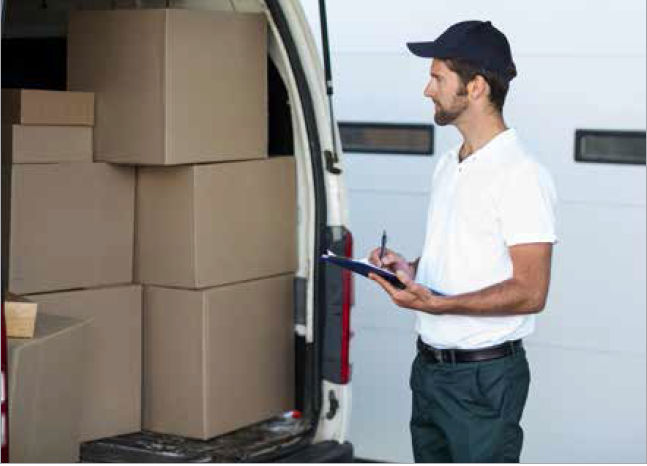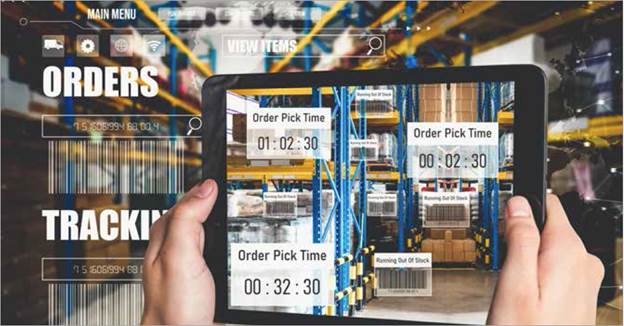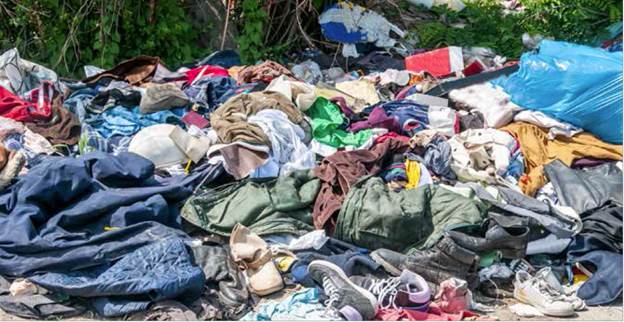The logistics sector accounts for a major share of carbon emissions, and the industry needs to step up and accept responsibility for carbon emission output and climate change. In fact, the sector needs to travel the way from ‘business as usual’ to ‘business is green’ by curbing its ever-growing carbon footprint.
Our world, as we know it, is changing. Having been abused and exploited by human activity, the very thing that sustains us is disintegrating in front of our eyes. If companies do not act, then over the next 10 years we will see parts of our world become inhospitable to humans with an unprecedented rate of floods, droughts, forest fires, storms and heatwaves. In 2020, we witnessed the world’s hottest1 year on record, with average global temperatures 1.2°C warmer2 than the average during 1951-1980, a timeframe that represents preindustrial conditions. With humaninduced global warming increasing at0.2°C per decade3, we are on track to see a temperature increase of 3°C-5°C by the end of the century4. Global leaders stepped up to curb this rise in temperature at the COP26 summit that took place from October 31 to November 12 in Glasgow, Scotland.They came together to accelerate the action necessary to achieve the goals of the Paris Agreement5 and the UN Framework Convention on Climate Change6.
What Is The Logistics Sector?
When looking towards the industries which need to step up and accept responsibility for carbon emission output and climate change, the logistics sector as a whole needs to be addressed.Transport contributes to 24 per cent of direct global CO2 emissions7 with global transportation burning through the world’s limited carbon budget. What is even more alarming is that global transportation is projected to double by 2050 according to The International Transport Forum (ITF)’s Transport Outlook 2021 report8. If this projection turns true, then emissions from traffic transport alone will increase by 16 per cent when compared to 2015 emissions, making the global agreements such as the Paris Agreement’s goals unachievable. The logistics sector involves more than transportation; it includes everything in the supply chain, from manufacturer to end-consumer. It includes how resources are acquired and stored, as well as transported. When looking at how materials are sourced and packaged, raw material production accounts for roughly 19 per cent of global greenhouse gas emissions9 and it is no secret that the packaging (poly/ plastic) of products is detrimental to our environment. The world is overrun with plastic waste and our atmosphere is polluted from the fossil fuels burned to make it. Thus, the logistics sector is both highly complex and multilocational impacting the world on many levels.

The E-Commerce Push
During the COVID-19 pandemic, the digital and e-commerce world was sent into a frenzy. The surge of online activity resulted in the e-commerce share of global trade increasing to 17 per cent in 2020 when compared to 14per cent in 201910.
The consequence of this digital transformation means that more transportation is required to deliver ordered goods to the consumer. One report has shown that US online retail sales increased 32.4 per cent contributing an additional $105 billion11 in online revenue. The problem is that with the push of e-commerce, comes more transportation needed to deliver, more warehouses needed to store the products and more packaging needed to pack the products—essentially amplifying the carbon footprint of the logistics sector.
The Fashion Industry And The Logistics Sector
Nicknamed ‘fashion’s biggest reset’12, the fashion industry was hugely impacted by COVID-19 with businesses having to adapt to the virtual world to survive. Last year, Spanish fast fashion retailer Zara’s online net sales increased by 64 per cent when compared with 201913, totalling its e-commerce net sales to €5.9 billion. Consumer habits have most likely changed forever, with people more in favour of e-commerce than ever before. But what does this behavioural change mean for the carbon footprint of the fashion industry concerning its logistical processes? Around 10 per cent of global carbon emissions14 are accounted from the fashion industry—a factor enough for the industry to shift to more sustainable practices15. To meet the agreed 1.5 degree pathway set out by the Paris Agreement in 2015, the industry needs to cut its emissions down to 1.1 billion metric tons of CO2 equivalent by 203016. However, current projections indicate that the industry is on its way to overshoot the target by almost twofolds, with emissions predicted to hit 2.1 billion metric tons of CO2 equivalent in 203017, unless mitigations are put in place to reduce the CO2 emitted throughout the entire logistics sector of apparel.
Apparel logistics include the processes that take place during the supply chain, filtering down from the manufacturer to the retailer and then the end-consumer. With the growing developments of e-commerce, retailers are offering consumers speedy, next day delivery, free returns, and a surplus of micro season apparel. But, at what cost? The costs are as bad as you think. With fast fashion taking over the world of retail, the environment falls victim to consumers’ fresh new looks. It starts at the very beginning of the manufacturing process, with the raw materials sourced to make clothes. Fifty per cent of fast fashion that is sold online18 is made up of synthetics like polyester, acrylic and nylon, with online brands leading the trend of environmental destruction. Furthermore, studies have shown that only one per cent of these online clothes were derived from recycled fabric, leaving the remaining 99 per cent to be made of virgin material. The carbon footprint of virgin polyester was found in a recent study to be 119.59 kgCO2/100 kg19, ten times the amount of virgin polyester. An additional study showed that recycled polyester produced 79 per cent fewer carbon emissions20 than virgin polyester. Polyester does not biodegrade and as an oil-based plastic, it remains in our environment for hundreds of years, breaking down into microplastics further exposing organisms to high concentrations of toxins and contaminating our oceans.

Further down the logistical chain of fashion comes the packaging used to store and wrap the apparel. Sustainably sourced packaging and delivery may come at a higher cost to the business or retailer, however, a recent report stated that 50 per cent of consumers21 are prepared to pay more for sustainable packaging and delivery. Therefore, businesses and retailers need to adapt, realising that the consumers are ready to adjust with them. With at least 8 million tons of plastic22 entering our oceans each year, the dependency on plastic, a material so destructive, needs to stop. Plastic has a carbon footprintof 6 kg CO2 per 1 kg23 – it is the most polluting material in our world and contributes to greenhouse gas emissions long after it has served its short lived purpose.
We have already mentioned the impact of the transportation sector when it comes to carbon emissions. Burning through our carbon budget, transportation is a major contributor. The vast majority of our clothes are made in least developed and developing regions of the world where labour cost is comparatively low. The main exporting countries for apparel include Vietnam, Bangladesh, India, China, Vietnam, Ethiopia, Indonesia, Sri Lanka and the Philippines.
Despite the ethical and moral implications associated with outsourcing apparel to these countries, it also means that there is a large environmental cost when it comes to transporting them to their final destination. In 2020, Vietnam’s value of exported textiles and garments was worth $35.2 billion24 and
83 per cent of Bangladesh’s exports25 were readymade garments. Globally, the fashion industry produces somewhere around 80 to 150 billion items a year, with 60 per cent of all produced clothing ending up in landfill or incinerated,26 further adding to the growing carbon footprint of the industry. Aligned with the consumer desire for speed and convenience comes the business model Next Day Delivery – ‘Order before 10 p.m. and get your clothes by 2 p.m. tomorrow!’ Workers are being pushed to their limits and the environment is exhausted in the process. Consumers are promised delivery within a matter of hours and the environmental costs of this are huge.
With more deliveries come more vans, with it comes more traffic, and therefore more air pollution – one can see the emerging trend. When consumers select next day delivery, they often do not realise that their need for speed overrides the need of the planet. Retailers, so desperate to deliver the consumer goods at such a rapid turnaround, allow for their vans to go and deliver the goods half empty, prioritising delivery time over efficiency and common sense. The fact is that if a vendor was given a five-day window to deliver the items, then they could more efficiently wait for the van to be filled, minimising the number of journeys needed to deliver the items and limiting the pressure put on the staff to meet unrealistic deadlines.
Understanding Carbon Footprint
A carbon footprint, quite simply, is the amount of greenhouse gas emissions released directly and indirectly by a person, event, organisation or product. Therefore, when looking at ways to minimise this carbon footprint, first identify the areas emitting the most carbon and then work backwards from there reducing the emissions from the corresponding areas. A carbon audit is always a good place to start when looking to minimise emissions. A carbon audit helps to distinguish the quantity and contributory causes of greenhouse gas emissions. Keeping track of carbon emissions is a great way to understand the impact a business has on the environment and allows for transparency so that people are aware of the steps being taken to move towards a greener future. More and more emphasis is being put on transparency, with the world highlighting the importance for businesses to take responsibility and prioritise the planet. Until carbon regulations and legal imperatives are fully implemented in society, consumers are putting their trust in the business to be environmentally conscious and take responsibility for their emissions.

Minimising Greenhouse Gas Emissions
As we now know, the logistics sector plays a huge role in warming our world. It is essentially the supply chain of a whole product and therefore affects global manufacturing and distribution. Companies can reduce their carbon footprint; they just need to start at the beginning and push for a greener chain of events.
Material And Supplier Management
During the manufacturing process, raw materials are used which release large amounts of carbon into the air. Therefore, companies that switch to green suppliers that use recycled material and avoid materials such as virgin PET, will instantly reduce their CO2 emissions and thus their carbon footprint. The type of material used, combined with the processes used to make it, contribute to greenhouse gases. Therefore, it is best to avoid suppliers who are still engaging with environmentally exhaustive processes and instead prioritise the ones who are minimising their reliance on raw materials, moving towards the circular world that the earth is so desperately in need of.
Warehouse Emissions
In global supply chains, large warehouses are required to store goods, however, the energy that is used to cool, heat, and power these warehouses is at large, hugely inefficient. Warehouses can easily be made more energy efficient which would consequently cut costs, minimise overheads and reduce carbon emissions. If nonrefrigerated warehouses switch to LED lighting, it is estimated that electricity costs would be cut by 70 per cent27. Additionally, warehouses that use solar panels or renewable energy instantly cut costs and carbon emissions. There are many ways to reduce the carbon footprint of warehouses, it is just about understanding the energy being used and then seeking out greener and more sustainable alternatives.

Space Utilisation And Transport
We have already touched on the impact of Next Day Delivery, changing the narrative around delivery times and waiting for vans vendors to be filled before dispatching products. These simple actions will instantaneously reduce the environmental and social impacts. In addition to this, when it comes to packaging these products, there is a need to question the way products are packaged – is the space being effectively used? Can packages be slotted together more efficiently and has the amount of plastic packing been reduced as much as possible? All these factors when combined will help reduce carbon footprints and improve the well-being of the workers involved. Moving towards sustainability is no longer a choice. Humans have been existing and acting as if the planet is an indestructible object, a mere accessory to humanity’s needs. However, the planet, responding to the years of exploitation and abuse requires people to reflect and adapt in ways that will allow the coexistence of both. Every industry and sector must consider ways to mitigate their environmental impact, having a positive influence, and not the incessant negative that continues to exhaust the earth.
References:
1https://www.nasa.gov/press-release/2020-tied-for-warmest-year-on-record-nasaanalysis-
shows
2https://www.nasa.gov/press-release/2020-tied-for-warmest-year-on-record-nasaanalysis-
shows
3 https://www.ipcc.ch/sr15/chapter/chapter-1/
4 https://public.wmo.int/en/media/press-release/wmo-confirms-2019-secondhottest-
year-record
5 https://unfccc.int/process-and-meetings/the-paris-agreement/the-paris-agreement
6 https://unfccc.int/process-and-meetings/the-convention/what-is-the-unitednations-
framework-convention-on-climate-change
7 https://www.iea.org/topics/transport
8 https://www.itf-oecd.org/itf-transport-outlook-project
9https://www.intereconomics.eu/contents/year/2016/number/4/article/the-climatechange-
impact-of-material-use.html
10 https://unctad.org/webflyer/covid-19-and-e-commerce-global-review
11 https://www.digitalcommerce360.com/article/coronavirus-impact-online-retail/
12 https://www.bcg.com/en-us/publications/2020/fashion-industry-reset-covid
13 https://cross-border-magazine.com/zara-online-stores-break-growth-records/
14https://www.worldbank.org/en/news/feature/2019/09/23/costo-moda-medioambiente
15https://unfccc.int/climate-action/sectoral-engagement/fashion-for-global-climateaction
16 https://www.mckinsey.com/industries/retail/our-insights/fashion-on-climate
17 https://www.mckinsey.com/industries/retail/our-insights/fashion-on-climate
18https://www.thersa.org/press/releases/2021/half-of-fast-fashion-entirely-made-ofnew-
plastics-study
19 https://journals.sagepub.com/doi/abs/10.1177/00405175211006213
20 https://compareethics.com/how-sustainable-is-recycled-polyester
21https://www.smurfitkappa.com/newsroom/2021/consumers-say-sustainablepackaging-
influences-their-purchasing-decisions
22 https://www.iucn.org/resources/issues-briefs/marine-plastics
23 https://stopplastics.ca/carbon-footprint-plastic
24https://www.statista.com/statistics/986023/vietnam-export-value-textilesgarments/
25https://www.statista.com/statistics/987683/bangladesh-garment-share-totalexports/
26https://www.vox.com/the-goods/2020/1/27/21080107/fashion-environment-factsstatistics-
impact
27 https://prod-drupal-files.storage.googleapis.com/documents/resource/restricted/
Warehousing%20and%20logistics%20guide.pdf
This article was first published in the December 2021 edition of the print magazine.











Comments